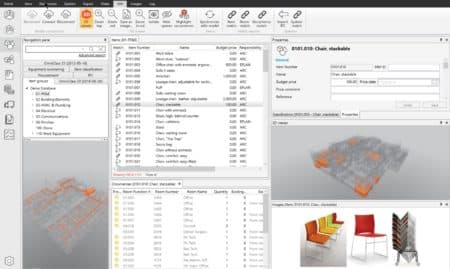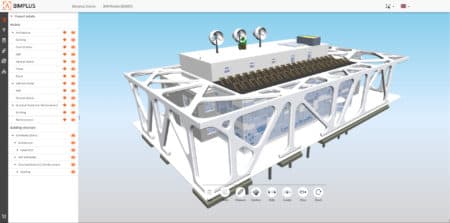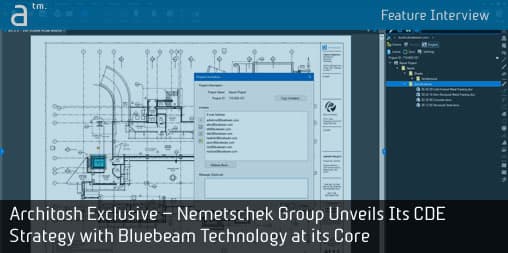Continued from page 1
Nemetschek CDE—Early Goals
On a three-way conference call, both Don Jacob and Sean Flaherty told me that the Group is first looking at the UK market as one of the primary test beds for their CDE development plans. This doesn’t mean that the solutions will only be UK-bound, rather it means that due to the BIM mandates by the government of the United Kingdom, that country serves as a critical market and one that aligns with where Bluebeam is experiencing strong growth, outside the United States where its market share is already very high.
“Customers are becoming increasingly sophisticated and we are expanding beyond just getting customers into BIM solutions,” says Flaherty. “The big trend now is getting customers into a complete digital workflow. And there is a greater workflow to be solved than BIM that runs through all the phases. We also need to consider the many other sources of information beyond the model.” Again, a CDE is not limited to data assets coming from a BIM environment. And a key issue in inefficiency in the AEC industry is that the industry is still very much reliant on manual processes rather than digital ones.

02 – dRofus is a sister company within the Nemetschek Group which possess its own BIM server. These will tie into the future group’s CDE.
“BIM Level 2 is about exchanging information without paper, or simple exchanges like e-mail or shared drives,” adds Flaherty, as he discusses the UK’s government BIM mandates for the country. Stating that the Group feels that on the standard side of things the UK has come into the lead, he adds, “according to one analyst, in the market only about 16 percent are meeting BIM Level 2 in the UK.”
“The big news today,” says Sean, “is we are working as a group on a CDE to meet our common document and process needs. The immediate goal is meeting those BIM Level 2 requirements as the first step for the Group and its CDE initiatives.”
Nemetschek CDE—A Global Picture
Readers may be wondering how Bluebeam’s Studio technology interrelates to the BIM server technologies already present in Nemetschek Group software tools. “The Group has four BIM servers,” says Don Jacob, noting that Group companies are still going to have native BIM server solutions. “Other brand solutions will serve different functions,” says Flaherty, “such as BIM model coordination or BIM asset management, for example. Flaherty further explained that the CDE will tie the group’s BIM servers together to leverage the collaborative strength across the group’s offerings. Bluebeam will handle document and process needs while linking to the other servers in the group to add model workflows.
You don’t want to force people into 3D models because this may not necessarily be the most efficient way to share the information in the field—it’s about getting access to the information in the form that makes the most sense to the people needing to use the information.
Both Flaherty and Jacob emphasis that CDE’s are more than BIM; a big part of initial goals are just meeting the UK’s BIM Level 2 requirements of converting to digital processes,” and this means getting data that lives in silos, especially as related to discreet files, into the common data environment. “Our CDE wants to be flexible, not rigid because that can negatively impact the project,” says Jacob, “so users don’t have to game the system that is supposed to be helping them.” They see that data will be held in a series of linked servers rather than a single, all-in-one platform.
This comment can be taken as a criticism of rival CDE systems developing in the market. Key rivals to Nemetschek include Autodesk with its array of 360 cloud platforms and its cloud-based system called Project Quantum. Both Bentley and Trimble have rival CDE visions, a notable one being Trimble Connect which includes onboard BIM and non-BIM 3D model tools. But perhaps a more relevant set of rivals in the ensuring quest for dominance in AEC industry CDEs will be admittedly smaller software players. Companies like Procore with its ConstructionOS and Viewpoint with its set of integrated solutions.

03 – ALLPLAN’s BIMPLUS is another of the group’s BIM servers, and again will establish ties to the group’s CDE.
There are many vectors a common data environment can choose to focus and excel on, yet at this stage, both Jacob and Flaherty are selective in their choice of words and what they are willing to reveal. Bluebeam’s Jacob notes: “You don’t want to force people into 3D models because this may not necessarily be the most efficient way to share the information in the field—it’s about getting access to the information in the form that makes the most sense to the people needing to use the information.”
Indeed, there are still many AEC firms that have yet to make the jump to BIM, de-emphasizing 3D models—or a slight upgrading of emphasis on non-geometrical information—sends the message that Nemetschek’s CDE goals will remain nimble and agile, a message which the market will be grateful to hear but what its varied collection of sister companies also undoubtedly wants to hear as well.
“We will have multiple initiatives and have multiple milestones,” says Jacob about the Group’s plans, “and these will be coming out over the next few years.” “The feature story today,” adds Flaherty, “is that these initiatives are going to be a part of the brands’ stories moving forward.”
Learning More
To learn more about the Nemetschek Group and its AEC software and services companies, visit them online here: www.nemetschek.com






Reader Comments
Comments for this story are closed